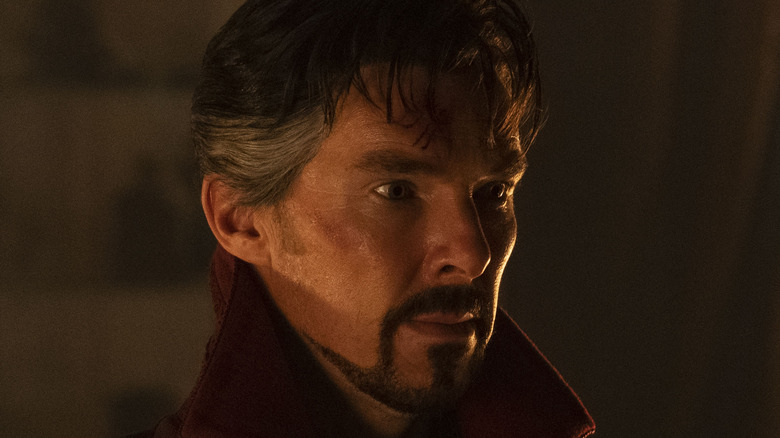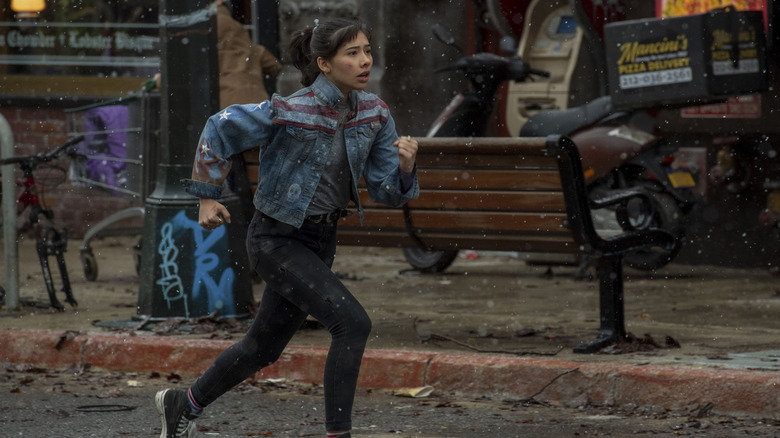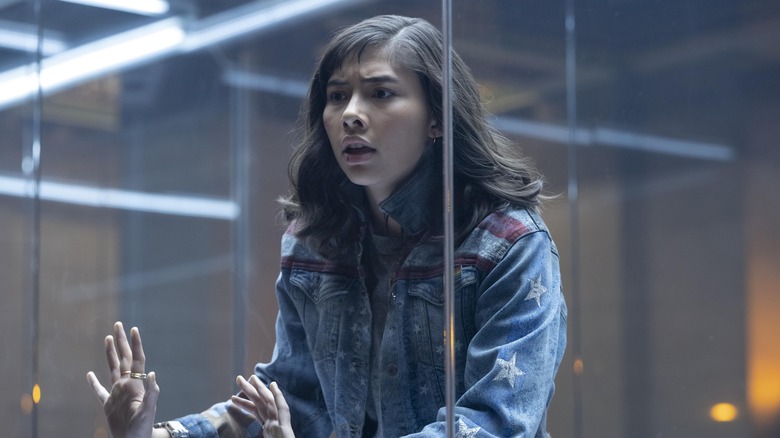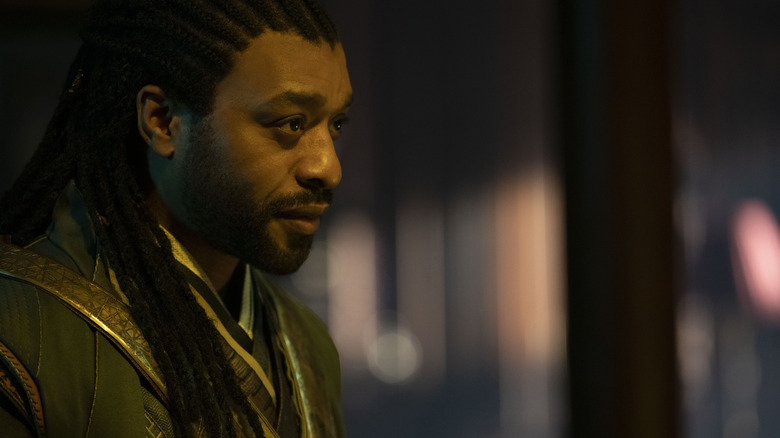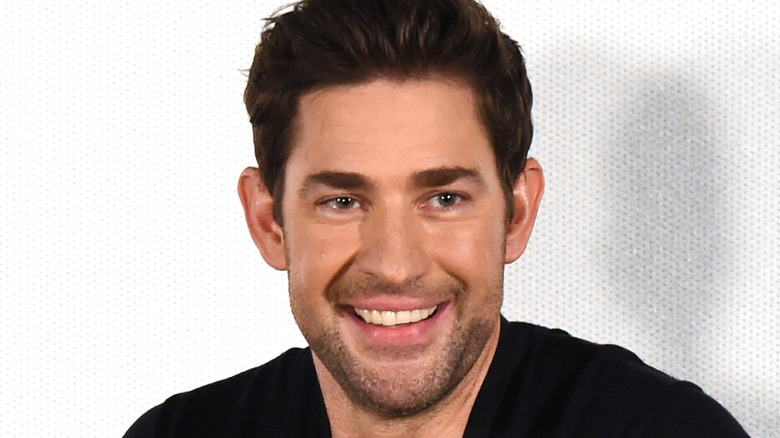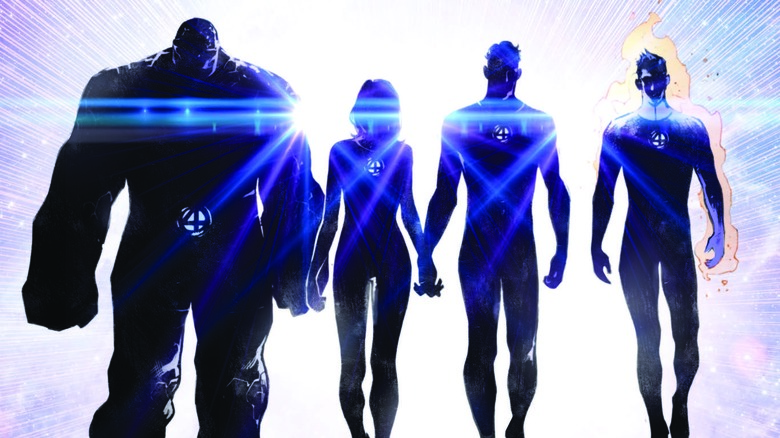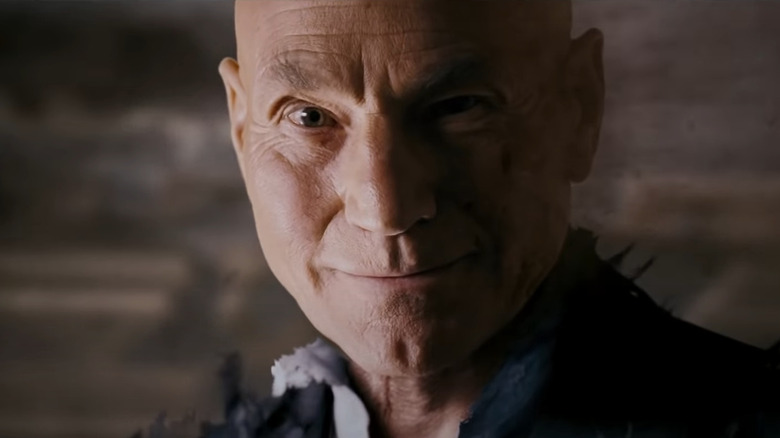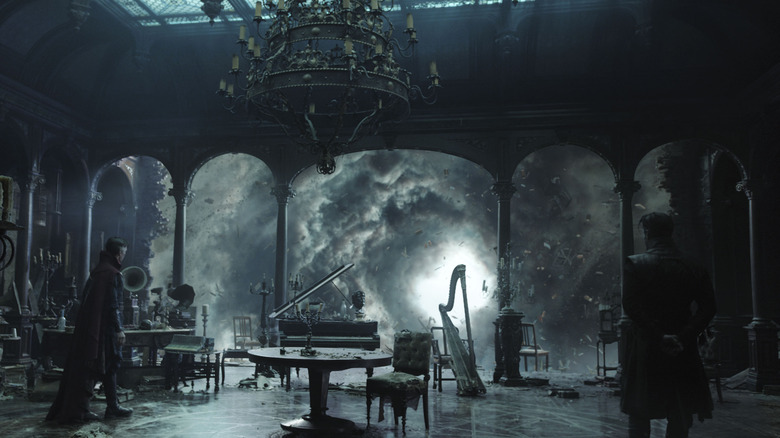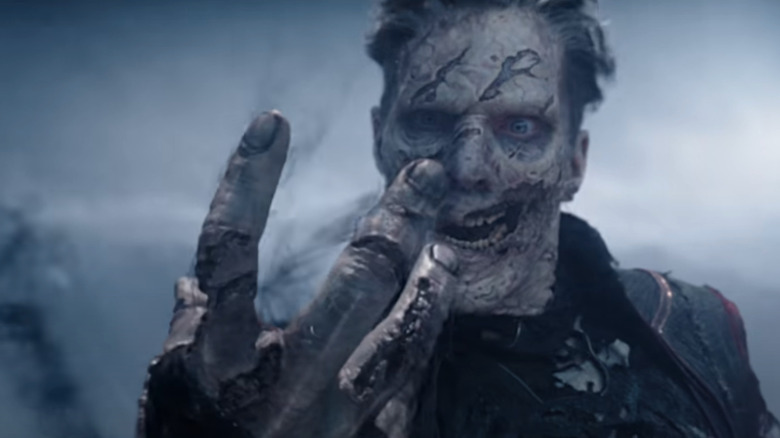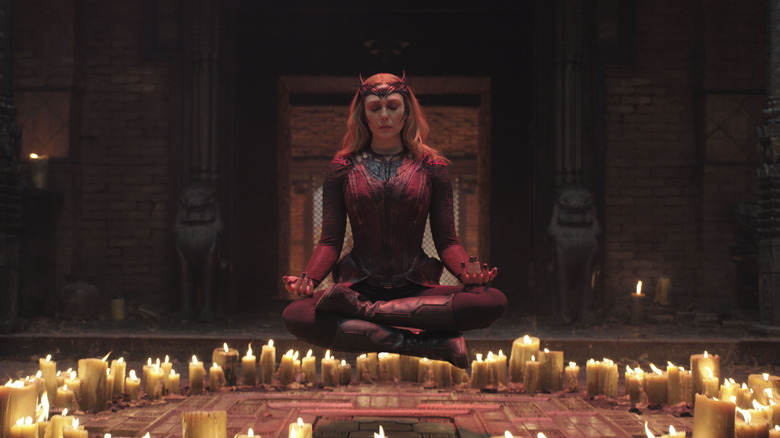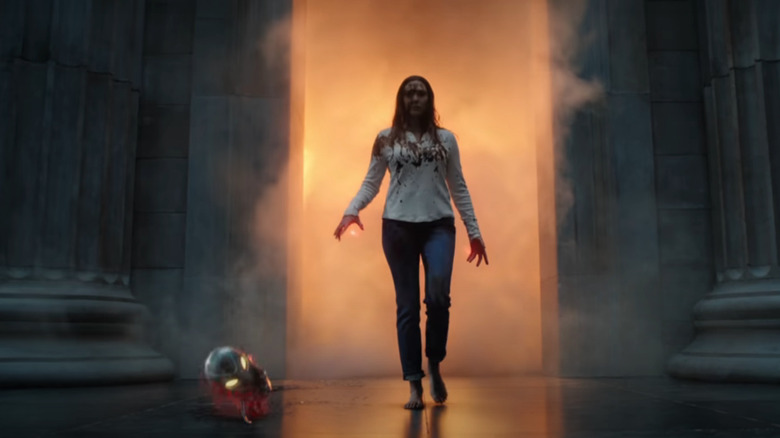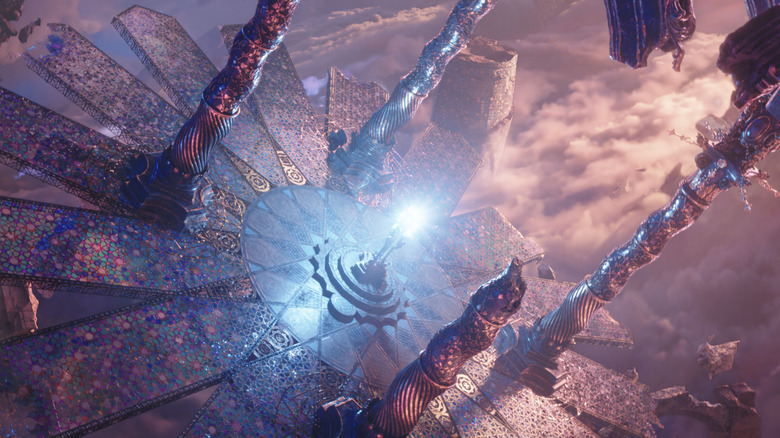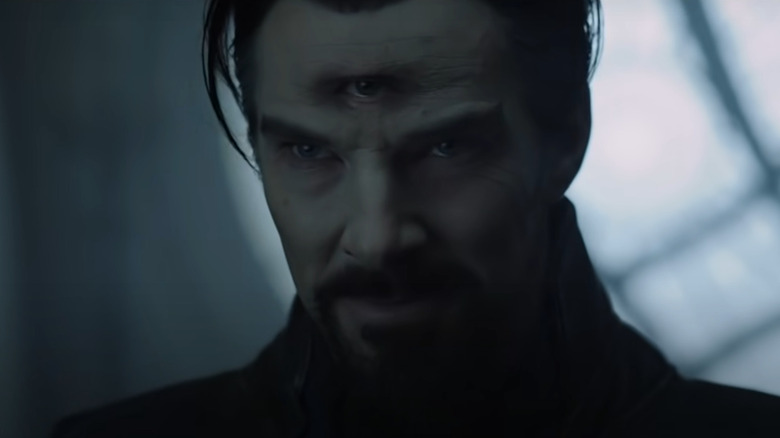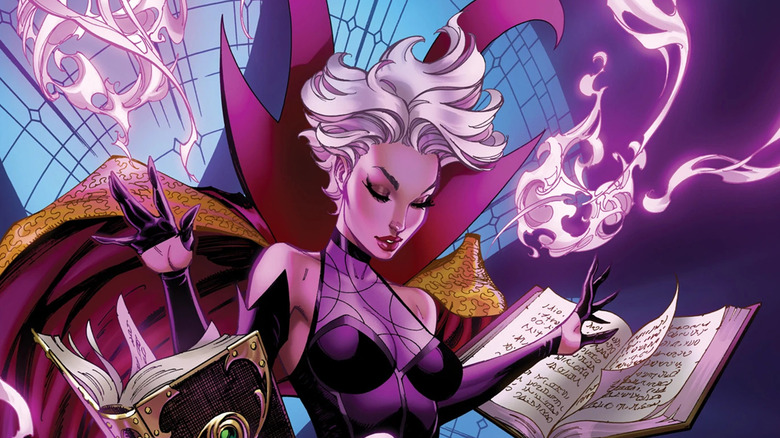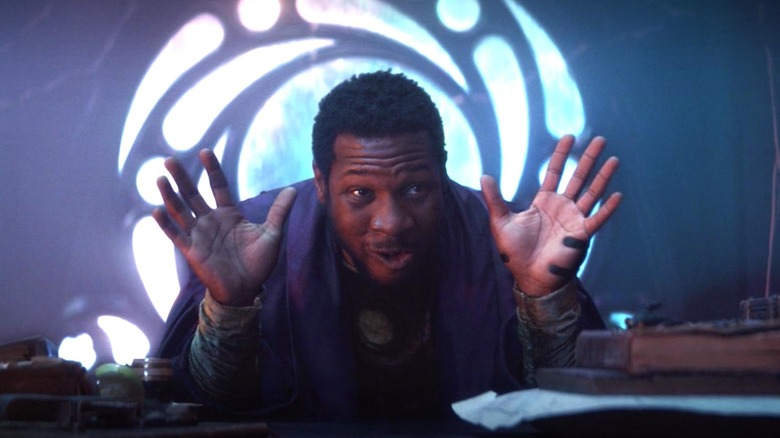Biggest Unanswered Questions From Doctor Strange In The Multiverse Of Madness
"Doctor Strange in the Multiverse of Madness" is one of the most bizarre, chaotic, and entertaining films ever to unfurl across the Marvel Cinematic Universe. From start to finish, it feels fresh and surprising, thanks to the combination of director Sam Raimi's horrifically stylish cinematic flair, the limitless possibilities of alternate Marvel realities, and an extensive cast of magic-wielding main characters. It's not perfect, but it's a fun and wild ride that shows just how much rich potential the MCU's multiverse has.
Of course, in a movie with so many new and returning characters, alternate realities, magical spells, and narrative twists, it's impossible to perfectly wrap up every individual plotline. This "Doctor Strange" sequel takes as much from the thriller and horror genres as it does from the MCU's signature action-adventure elements, so mysteries and cliffhangers are par for the course. The film also adds a ton to the overarching lore of Marvel films by exploring both magic and the multiverse, and while it provides some much-needed answers, it also leaves a number of big questions dangling.
The MCU keeps journeying deeper into the endless possibilities of its alternate universes, and Stephen Strange's latest adventure is a massive, maddening step forward. Ambitious and frequently breathtaking, the film is also confident enough to leave audiences with lots to chew on after the credits roll. From the darkest magic to a slew of new characters, here are the biggest (spoiler-heavy) unanswered questions in "Doctor Strange in the Multiverse of Madness."
Why is there only one America Chavez?
Right from the top, "Doctor Strange in the Multiverse of Madness" drops a lot of intriguing details about how the multiverse works. Past MCU installments like "Avengers: Endgame" and "Loki" have explored the idea of variants — alternate versions of characters from different realities — but this film takes things a step further.
In the film, it's revealed that dreams are windows into other universes. When you see yourself running from a monster, or falling from a building, or marrying the Pope in your dreams, it means that thing is actually happening to some version of yourself, somewhere out there in the multiverse.
The movie then upends this concept with the new character of America Chavez, played wonderfully by Xochitl Gomez. America has the power to travel through realities, and most of the film's plot revolves around the desire to control, or seize, these powers. Further differentiating her from the other characters in this saga, she reveals early on that in all her travels, she has never located any other versions of herself in other universes. She knows this both because she's looked — but also because she never dreams. It's a fascinating character trait, and it begs the question: Why?
Do America's powers have something to do with there only being one of her? Both of those traits make her a huge anomaly, but every anomaly in the Marvel universe has a reason behind it — an ancient god, a dark spell, a radioactive spider or something along those lines. America Chavez's has yet to be revealed.
What happened to America Chavez's parents?
Part of the mystery of America Chavez's abilities and her unique status in the multiverse could have to do with her home dimension. In the "Doctor Strange" sequel, there's a brief flashback scene that shows the moment America's powers first awakened, resulting in a tragic accident that had her mothers being sucked through a portal of their daughter's accidental creation. America understandably feels guilt over the catastrophe.
When Doctor Strange learns this information, she seems to have lost all hope, claiming that her moms are almost certainly dead. The good doctor responds with an encouraging word, saying that if they're anything like their daughter, they must have survived. "Doctor Strange in the Multiverse of Madness" could be just the first in a long line of MCU appearances for America, and if she becomes a leading figure in the franchise later on, it seems inevitable that her parents will pop back up. But where? And when? Will their story be connected to Kang the Conqueror, who is primed to cause multiversal mayhem after the events of "Loki" Season 1? Will America ever journey back to her Garden of Eden-like home dimension?
In the comics, America's original world is a place outside the multiverse called the Utopian Parallel, which could explain why she has no variants in the MCU. The Utopian Parallel also has ties to Wanda Maximoff's son Billy (AKA Wiccan) in the comics. Given how closely connected Scarlet Witch and America already are in the MCU, that could lead to some intriguing possibilities.
How did the Illuminati come to be?
One of the biggest twists in "Doctor Strange in the Multiverse of Madness" is the introduction of the Illuminati on Earth-838. The secret group is hugely important to the Marvel comics universe — a council of powerful figures who guide world events from the shadows and often make difficult decisions in the process. The 838 Illuminati are a staggering collection of variants, Marvel TV characters, previously non-MCU favorites, and popular fancasts.
The list is as follows: Black Bolt (Anson Mount reprising his role from ABC's "Inhumans"), Captain Marvel (Lashana Lynch's Maria Rambeau), Captain Carter (previously glimpsed in "Marvel's What if...? and played by Hayley Atwell), an alternate version of Karl Mordo (Chiwetel Ejiofor), John Krasinski's Reed Richards, and Patrick Stewart's Professor Charles Xavier. It's an impressive roster that also leaves a lot of hanging questions about the future of the MCU.
For starters, some of the Illuminati members' individual origin stories are left unaddressed. What happened to Steve Rogers in this universe, and was Captain Carter's origin the same as in "What if...?" More importantly, the Illuminati makes three major Marvel character groups official in the MCU: the Inhumans (whose canonical status was left unclear when the ABC series ended), the X-Men, and the Fantastic Four. It's unknown how each of them came to be in Universe 838, but it seems likely that they'll all factor into the franchise's future. Perhaps a new, cross-dimensional Illuminati could form. Or maybe Marvel Studios' "Fantastic Four" and "X-Men" films will take place far away from Earth-616 (the main MCU reality). Only time will tell.
Will John Krasinski's Reed Richards return?
While each member of the Illuminati in "Doctor Strange in the Multiverse of Madness" is somewhat surprising, John Krasinski's Mr. Fantastic is arguably the biggest deal. The "Office" alum has been a popular choice among fans to play the character for years, so it's satisfying to finally see him don the character's iconic blue spandex. Not only that, but Krasinski seems perfect for the role, even with the relatively limited amount of screen time he gets in the "Doctor Strange" sequel. He pulls off Reed Richards' measured and kindhearted authority with flying colors, setting the stage for a stellar lead performance in the MCU's upcoming "Fantastic Four" movie.
However, when that movie finally comes around, it will feature a different version of Reed altogether. Universe 838's Mr. Fantastic is shredded into pieces by the Scarlet Witch, blocking him from returning in any future installments. Does that mean that we've seen the last of Krasinski's take on the character? Surely not. You don't get such a big star for a debut appearance without ambitious plans for the future. That means that Krasinski will probably return as a different Reed Richards variant (of which there are plenty) in the next "Fantastic Four" film. Will he be in the main MCU reality, now officially dubbed Earth-616? Or will he come from some other corner of the multiverse? That much remains to be seen.
Where are the other MCU Fantastic Four members?
John Krasinski's Reed Richards arrives at the Illuminati meeting in this "Doctor Strange" sequel with his group's signature "4" emblazoned upon his chest. He later confirms that he has children, and that their mother — presumably Sue Storm — is alive and well. That information might not seem hyper relevant, since Reed subsequently meets his demise at the hands of Scarlet Witch, but it seems likely that the Mr. Fantastic variant who appears in an upcoming "Fantastic Four" movie will be in a similar life situation.
If Krasinski does play Reed again in that film, it will mean a more seasoned version of the team than the big screen has seen before. Previous attempts at adaptation — which generally begin before the characters get their superpowers — have all critically bombed, so starting the MCU version of the group in a more veteran place could be a great call. There have been rumors of Emily Blunt playing Sue Storm (which she has consistently shot down) opposite her husband's Mr. Fantastic, which perhaps seems more likely now. But who could play The Thing and the Human Torch? And how will the Fantastic Four as a whole connect with the rest of the MCU if they don't originate in Universe 616?
These are questions that don't yet have answers, but they certainly leave a lot of exciting options on the table. Traditionally, Kang the Conqueror has been a major antagonist to the Fantastic Four, so it's possible that Jonathan Majors' version of the character will play into their MCU story. And of course, when discussing these characters, a visit from Doctor Doom always feels like a distinct possibility.
Where are the other MCU X-Men?
Every bit as significant as John Krasinski's Mr. Fantastic is Patrick Stewart's appearance as Professor Charles Xavier, a role he's played for decades in the "X-Men" movies that (until now?) previously existed outside the MCU. While not explicit, Stewart's return via "Doctor Strange in the Multiverse of Madness" seems to confirm that all those old X-Men movies are canon within the MCU multiverse, as the Professor X present in the film can be seen as a variant of the one previously played by Stewart and James McAvoy. Nonetheless, the other X-Men aren't mentioned at all in this "Doctor Strange" sequel, and neither is the word "mutant." As of now, it's unclear how those aspects of the franchise will be tied back into the MCU.
There are a lot of options on the table. Stars of the later X-Men movies could potentially be brought back as variants, like Michael Fassbender or Nicholas Hoult. Alternatively, the main "X-Men" characters could be completely recast down the line, with those changes being justified by the multiverse. Marvel Studios and Disney could even continue the Fox "X-Men" series, although that seems like an unlikely option, particularly with the most famous one, Hugh Jackman as Wolverine, supposedly wrapped for good. Whatever happens, it should be exciting to watch.
What was Doctor Strange's incursion?
One of the pieces of lore introduced in "Doctor Strange in the Multiverse of Madness" involves incursions — cataclysmic events where multiple realities are smashed together. Earth-616's Stephen Strange is informed by the Illuminati that his 838 counterpart caused an incursion by using the Darkhold to dreamwalk — a crime punished by a brutal execution. Later on, Doctor Strange 616 meets a version of himself who has become deeply corrupted by the Darkhold and is implied to have caused his own incursions. Finally, at the end of the film, the comics character Clea (Charlize Theron) shows up and tasks Strange 616 with fixing an incursion she claims he caused.
None of these events are explained in detail, but they could be in further MCU installments. The end credits of "Multiverse of Madness" proclaim that Doctor Strange will return, and with Clea now in the MCU — a character with huge significance to Strange's comic book story — that next entry could be wilder than ever. "Doctor Strange 2" spends a lot of time talking about how uniquely dangerous its eponymous hero can be, and if that theme is to remain relevant going forward, it would make sense for the incursions he has caused to be explored in greater detail.
How does Doctor Strange control the dead?
One of the more bizarre moments in "Doctor Strange in the Multiverse of Madness" occurs at the end of the film. when the hero snatches a copy of the Darkhold from his evil counterpart. He then uses the spells within the tome to dreamwalk into the corpse of one of his other variants, who was buried on Earth-616 at the beginning of the film.
This doesn't sit well with the spirits of the dead, however, who quickly rise from their realm to accost Doctor Strange. Fortunately, Christine Palmer (Rachel McAdams) is there to help keep him grounded. She reminds him that he's a Master of the Mystic Arts and encourages him to use the spirits of the damned himself. He does just that, sucking up all the ghosties into himself and growing a pair of shadowy spirit wings on his zombified body.
It's all baffling and distinctly Sam Raimi, and it makes for a fun climax. However, the movie doesn't do a great job of actually explaining what happens. Has Doctor Strange always had the ability to control the spirits of the dead? Is it a power granted only to his zombie form, or by the Darkhold? Could any sorcerer potentially wield this ability? Now that all of the Darkholds are (theoretically) destroyed, we may never get concrete answers to these questions.
How did Scarlet Witch destroy every Darkhold?
Underlining how powerful the character is, in the end Scarlet Witch isn't defeated by Doctor Strange, or Wong, or America Chavez. She's brought down by her own sense of guilt — a fierce realization of the monster she's become. Face to face with her sons in an alternate reality, Wanda sees them look upon her with fear. The two little people she loves so much that she has murdered and destroyed on their behalf don't even recognize her as their mother, and the sheer weight of that epiphany finally overcomes Wanda's desire to steal America's powers. In an act that's both symbolic and (somewhat) redemptive, she brings the entirety of Mount Wundagore collapsing down upon itself with her inside, demolishing the ancient dark magic written there.
This destructive act of penitence has a curious side-effect: The erasure of every Darkhold from every corner of the multiverse. How exactly Wanda manages to pull off that feat, however, is unclear. The Scarlet Witch has the power to alter reality, so it's possible that the mountain magnified her powers in some way and allowed her to affect other universes. Even then, though, things don't quite add up. If there are Darkholds in most universes, it stands to reason that there are other versions of Mount Wundagore as well. Couldn't someone from one of those realities simply transcribe another book? Or did Wanda's magic erase the mountains in every universe as well?
Is Wanda alive?
Wanda's demolition of the Mount Wundagore temple would seem like a definitive end to the character. That is, it would seem that way if Kevin Feige hadn't already confirmed that she'll be back (per Deadline). The nature of her next appearance remains uncertain, however, and there are a lot of different ways it could play out. The existence of the multiverse means that the franchise could just lean on a variant of the character, one of whom plays a major role in "Multiverse of Madness." Given how much time has been spent building up Earth-616's Wanda, however, it seems like a missed opportunity not to continue her story in some capacity.
At the very least, it seems highly unlikely that a collapsing mountain would be enough to stop the Scarlet Witch. "Doctor Strange in the Multiverse of Madness" is basically a montage of her surviving every conceivable sort of attack, from armies of sorcerers and the powers of Captain Marvel to mental invasion by Charles Xavier. There's no way a few big rocks would be enough to keep her down ... right?
What happened to the Book of Vishanti?
A lot of the action in "Doctor Strange in the Multiverse of Madness" involves the Book of Vishanti, an ancient tome of good magic and the antithesis of the Darkhold. It's believed that the book contains spells that could stop the Scarlet Witch, but unfortunately, that theory is never confirmed. Just as Doctor Strange, Christine Palmer, and America Chavez reach the Book of Vishanti, Wanda destroys it with her dark magic.
But is the Book of Vishanti really gone? The place where it dwells is referred to as a world between realities, which suggests that — unlike the Darkhold — there is only one copy. Presumably, that means Wanda burned the only one in existence, removing it from the multiverse permanently. The truth may be a bit more complicated, however. Who's to say that the book didn't whisk itself off to some other place for safety, leaving only the illusion that it was destroyed?
Alternatively, it's possible that another copy does exist elsewhere. Because the MCU version of the tome never actually gets used in the "Doctor Strange" sequel, it's tough to theorize too much about what role it could play going forward. As long as magic remains important in the franchise, though, there's a chance that the Book of Vishanti could return.
Why does Doctor Strange get a third eye?
At the very end of "Doctor Strange 2," Stephen makes his way back to Earth-616 with a new lease on life. Everything seems normal and fine until Doctor Strange starts spasming in pain while walking down the street. The last shot before the first round of credits shows a third eye open in his forehead — similar to the one worn by his sinister counterpart earlier in the film.
There are a few possible explanations for Doctor Strange's third eye. The Eye of Agamotto, acquired by Strange in his first solo film, has a number of powers in the comics that haven't yet featured in the MCU. The big-screen version of the Eye is mainly used to hold the Time Stone, but in the original Marvel canon, it also brings powers of transcendent vision and knowledge, among other things. These abilities often manifest themselves in the form of a third eye. Since Agamotto himself is one of the Vishanti in the comics — powerful godlike beings who aid the Sorcerer Supreme and created the Book of the Vishanti — it's possible that Strange's interactions with the sacred tome or its opposite, the Darkhold, could have opened the Eye of Agamotto up to its true potential.
Alternatively, Doctor Strange could have simply reached a new level of mystical power through the story of "Multiverse of Madness," thus unlocking the secrets of the Eye. Either way, he seems stronger than ever.
Where is Clea taking Doctor Strange?
The first post-credits scene in "Doctor Strange in the Multiverse of Madness" introduces Clea, a woman from an alternate reality played by Charlize Theron. She approaches the Stephen Strange of Earth-616 in full purple battle garb and demands him to help her fix an incursion he apparently caused. Popping open his newfangled third eye, Strange quickly states that he's ready to roll, and the two leave through a portal carved by Clea's shimmering sword.
In the comics, Clea is a denizen of the Dark Dimension with close ties to Dormammu himself. Given that her purple hue is resemblant of Dormammu's MCU incarnation and that the universe she opens a portal to in "Doctor Strange 2" looks similar to the Dark Dimension in some ways, it's likely that this backstory will continue to hold true. Of course, she makes no mention of her home or of Dormammu during the post-credits scene, so it's yet to be revealed what the nature of her character will be in the MCU.
One thing of particular importance to note is that Clea ends up marrying Doctor Strange in the comics. Since he seems to have made his peace with the fact that he'll never settle down happily with Christine by the end of his second film, the MCU could be building a new love story between him and Clea.
Where is Kang the Conqueror?
While not particularly relevant to the specific story of "Doctor Strange in the Multiverse of Madness," Kang the Conqueror looms large over the whole film. From the dimension-hopping nature of the story to the introduction of Reed Richards, there are tons of plot details that silently hint at the villain's MCU return.
At the end of "Loki" Season 1, the God of Mischief finds himself in a severely altered Time Variance Authority that seems to be run by Kang. Presumably, that means that he could be active in his conquest by the events of the "Doctor Strange" sequel, but it's possible that he doesn't yet possess a way to easily travel across dimensions. In that instance, America Chavez would be of special interest to him, just as she is to Wanda Maximoff. While it makes sense not to overcrowd any one movie with too many characters or storylines, Kang could nonetheless be impacted by the events of "Multiverse of Madness." He's set to appear in "Ant-Man and the Wasp: Quantumania," if not sooner, and it should be interesting to see where the MCU takes him.
